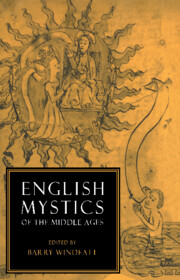Book contents
- Frontmatter
- Contents
- Acknowledgements
- Abbreviations
- Editorial note
- Introductory essay
- RICHARD ROLLE (c. 1300–1349)
- ANONYMOUS
- WALTER HILTON (d. 1396)
- 9 Epistle on the Mixed Life
- 10 Of Angels' Song
- 11 Eight Chapters on Perfection
- 12 The Scale of Perfection, Book I
- 13 The Scale of Perfection, Book II
- 14 Qui Habitat
- 15 The Prickynge of Love
- JULIAN OF NORWICH (1342– after 1416)
- MARGERY KEMPE (c. 1373– C. 1440)
- ANONYMOUS ENGLISH TRANSLATORS
- RICHARD METHLEY (1451/2–1527/8)
- Notes
- Guide to further reading
- Glossary
12 - The Scale of Perfection, Book I
Published online by Cambridge University Press: 06 July 2010
- Frontmatter
- Contents
- Acknowledgements
- Abbreviations
- Editorial note
- Introductory essay
- RICHARD ROLLE (c. 1300–1349)
- ANONYMOUS
- WALTER HILTON (d. 1396)
- 9 Epistle on the Mixed Life
- 10 Of Angels' Song
- 11 Eight Chapters on Perfection
- 12 The Scale of Perfection, Book I
- 13 The Scale of Perfection, Book II
- 14 Qui Habitat
- 15 The Prickynge of Love
- JULIAN OF NORWICH (1342– after 1416)
- MARGERY KEMPE (c. 1373– C. 1440)
- ANONYMOUS ENGLISH TRANSLATORS
- RICHARD METHLEY (1451/2–1527/8)
- Notes
- Guide to further reading
- Glossary
Summary
(Chapters 44, 45, 46)
‘This hevenly boke more precyous than golde’ is the description of The Scale of Perfection in Wynkyn de Worde's edition of 1494, the first printed text of English mystical writing and published at the behest of Lady Margaret Beaufort, mother of Henry VII. The title seems ill-suited, in that imagery of a ladder (Latin: scald) is not the unifying concept, and other titles in the manuscripts include: De Vita Contemplativa (BL MS Add. 11748), and The Reformyng of Mannys Soule (BL MS Harley 2397). Whether the two books were intended as one work remains an open question: each assumes a different readership and, after an opening casting itself as a continuation, Book II scarcely refers back to Book I. Forty-one extant copies of Book I, as against twenty-five of Book II, point to the wider popularity of the more practical earlier work; only two manuscripts have Book II alone, while two further manuscripts include both books, but separated by other material.2 It may well be that Books I and II are separated by some years, and that they should be regarded more as two separate works than as two parts of the same work.
Book I of The Scale is written as if to an anchoress, and assumes that contemplative life is reserved to those vowed to the contemplative religious state. Hilton recurrently disclaims any mystical experience of his own, and in Book I the experience of contemplation remains, as it were, beyond the horizon. Hilton begins at the beginning with moral and ascetic teaching, expounding the attainment of the requisite virtues for those aspiring to contemplation, especially humility and charity.
- Type
- Chapter
- Information
- English Mystics of the Middle Ages , pp. 149 - 155Publisher: Cambridge University PressPrint publication year: 1994



